Birdfinding.info ⇒ The Venezuelan island endemic form of Bananaquit is locally common in Archipiélago de Los Roques National Park. The other islands in its range are not regularly surveyed.
“Blackish Bananaquit”
Coereba flaveola laurae
Endemic to Venezuela’s offshore islands: Isla Testigo Grande and Isla Conejo (laurae); the Los Roques Archipelago (lowii); and Cayo Sal (melanornis). May also include frailensis of Isla de Puerto Real and Morro El Fondeadero.
Identification
Distinctive: an all-dark Bananaquit, recognized as such by its curved, sharp-tipped bill and pink gape.
The only population that is well-documented, lowii of the Los Roques Archipelago, is mostly blackish but has somewhat paler grayish-olive tones on its belly and flanks.

“Blackish Bananaquit”, C. f. lowii. (Gran Roque, Archipiélago de Los Roques National Park, Venezuela; January 3, 2011.) © Mikko Pyhälä
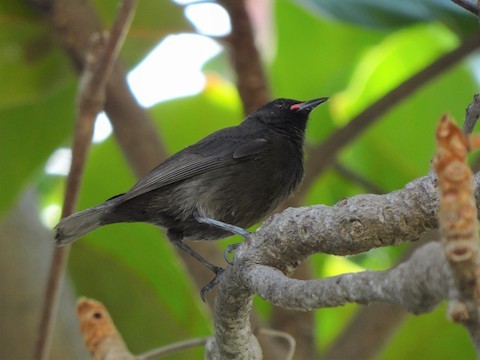
“Blackish Bananaquit”, C. f. lowii. (Cayo Crasqui, Archipiélago de Los Roques National Park, Venezuela; February 9, 2013.) © Mauricio Zanoletti
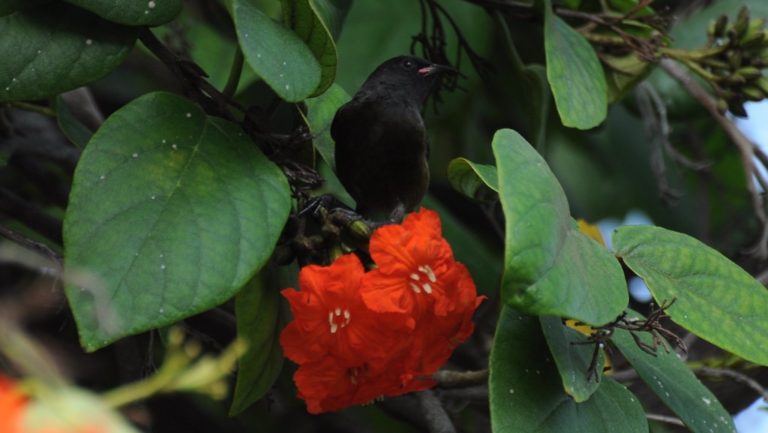
“Blackish Bananaquit”, C. f. lowii. (Archipiélago de Los Roques National Park, Venezuela; February 9, 2015.) © Diana Padron
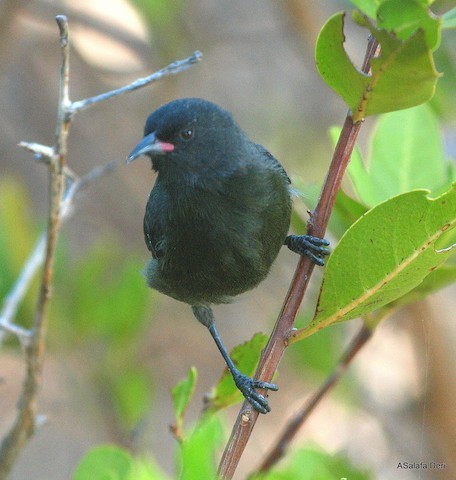
“Blackish Bananaquit”, C. f. lowii. (Archipiélago de Los Roques National Park, Venezuela; September 5, 2011.) © Fanis Theofanopoulos (ASalafa Deri)
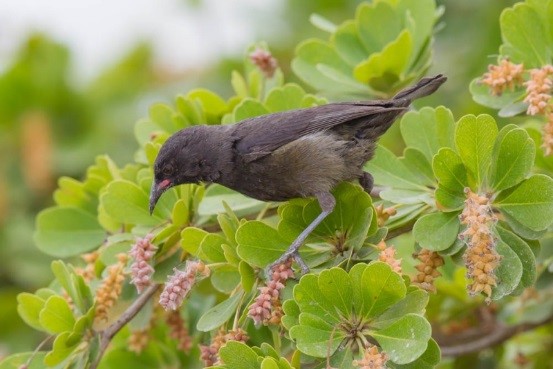
“Blackish Bananaquit”, C. f. lowii. (Gran Roque, Archipiélago de Los Roques National Park, Venezuela; April 7, 2016.) © Jeluba

“Blackish Bananaquit”, C. f. lowii. (Gran Roque, Archipiélago de Los Roques National Park, Venezuela; May 5, 2018.) © Juan Carlos Fernández-Ordóñez
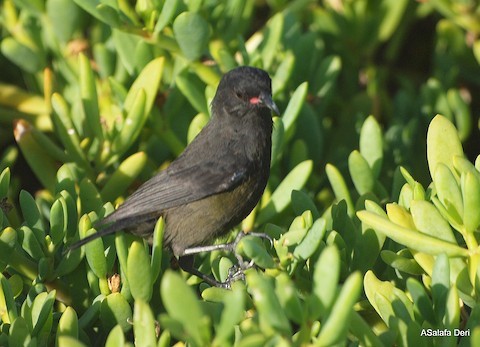
“Blackish Bananaquit”, C. f. lowii. (Archipiélago de Los Roques National Park, Venezuela; September 4, 2011.) © Fanis Theofanopoulos (ASalafa Deri)
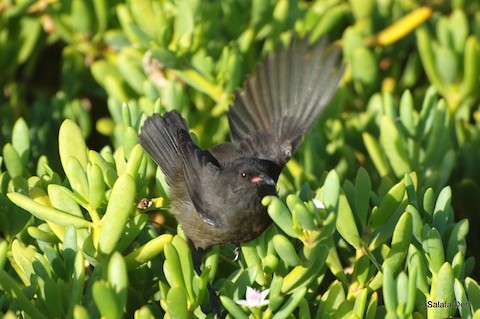
“Blackish Bananaquit”, C. f. lowii. (Archipiélago de Los Roques National Park, Venezuela; September 4, 2011.) © Fanis Theofanopoulos (ASalafa Deri)
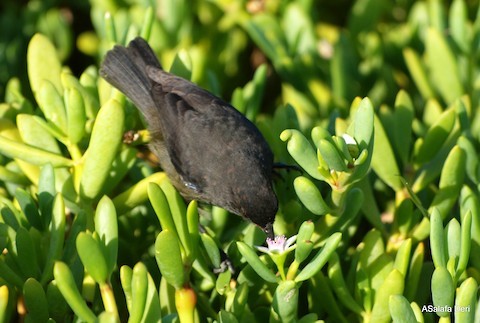
“Blackish Bananaquit”, C. f. lowii. (Archipiélago de Los Roques National Park, Venezuela; September 4, 2011.) © Fanis Theofanopoulos (ASalafa Deri)

“Blackish Bananaquit”, C. f. lowii. (Gran Roque, Archipiélago de Los Roques National Park, Venezuela; December 22, 2013.) © Lebsky Zamora
Cf. “Dimorphic Bananaquit”. The dark morph of “Dimorphic Bananaquit” of St. Vincent, Grenada, and the Grenadines looks very much like the “Blackish Bananaquit” of Venezuela’s offshore islands. Both are essentially all-dark with a pink gape, and their voices have approximately the same quality. The “Blackish” population of Los Roques is paler than the dark morph of “Dimorphic”, especially on the belly and flanks—but the other populations are not well documented.
Notes
Polytypic form consisting of three or four recognized subspecies (laurae, melanornis, lowii, and possibly also frailensis), collectively comprising one of approximately ten potentially distinct forms of Bananaquit. Presumably closely related to the geographically proximal “Dimorphic Bananaquit” (aterrima of Grenada and atrata of St. Vincent), whose dark morph is extremely similar to “Blackish”.
Frontiers of Taxonomy: Bunches of Bananaquits. The forty-or-so subspecies of Bananaquit vary significantly in plumage and voice, and it seems clear that what has traditionally been recognized as a single species consists of several distinguishable forms, which likely represent at least two species, and perhaps as many as ten, but it is a complex puzzle.
Mitochondrial DNA analysis (Bellemain et al. 2008) indicates that the oldest splits are among three lineages: “Bahama” (bahamensis, plus the “Cozumel” subspecies, caboti); “Greater Antillean” (Jamaican flaveola, Hispaniolan bananivora, “Cayman” sharpei, and possibly also the similar “Providencia” form, which includes tricolor and oblita); and the rest (which can be subdivided into “Lesser Antillean” and “Continental” groups).
The same analysis indicates that oldest division among the “Lesser Antillean” lineages is “Puerto Rican” (portoricensis—and possibly also sanctithomae and newtoni of the Virgin Islands), which has the appearance of “Greater Antillean” with a “Lesser Antillean” voice. The analysis also found a significant division between the “Dimorphic” form (aterrima of Grenada and atrata of St. Vincent) and the remaining “Lesser Antillean” subspecies (bartholemica plus martinicana, barbadensis, uropygialis, and bonairensis). Finally, not sampled in the analysis, but apparently related to “Dimorphic”, is the Venezuelan “Blackish” form (laurae plus melanornis, lowii, and possibly also frailensis).
References
Ascanio, D., G.A. Rodriguez, and R. Restall. 2017. Birds of Venezuela. Christopher Helm, London.
Bellemain, E., E. Bermingham, and R.E. Ricklefs. 2008. The dynamic evolutionary history of the bananaquit (Coereba flaveola) in the Caribbean revealed by a multigene analysis. Evolutionary Biology 8:240.
Bellemain, E., O.E. Gaggiotti, A. Fahey, E. Bermingham, and R.E. Ricklefs. 2012. Demographic history and genetic diversity in West Indian Coereba flaveola populations. Genetica 140:137-148.
BirdLife International. 2016. Coereba flaveola. The IUCN Red List of Threatened Species 2016: e.T22722080A94747415. https://dx.doi.org/10.2305/IUCN.UK.2016-3.RLTS.T22722080A94747415.en. (Accessed May 22, 2021.)
eBird. 2021. eBird: An online database of bird distribution and abundance. Cornell Lab of Ornithology, Ithaca, N.Y. http://www.ebird.org. (Accessed May 22, 2021.)
Kirwan, G.M., A. Levesque, M. Oberle, and C.J. Sharpe. 2019. Birds of the West Indies. Lynx Edicions, Barcelona.
Meyer de Schauensee, R., and W.H. Phelps, Jr. 1978. A Guide to the Birds of Venezuela. Princeton University Press.
Raffaele, H., J. Wiley, O. Garrido, A. Keith, and J. Raffaele. 1998. A Guide to the Birds of the West Indies. Princeton University Press, Princeton, N.J.
Ridgely, R.S., and G. Tudor. 1989. The Birds of South America, Volume I: The Oscine Passerines. University of Texas Press.
Seutin, G., N.K. Klein, R.E. Ricklefs, and E. Bermingham. 1994. Historical Biogeography of the Bananaquit (Coereba flaveola) in the Caribbean Region: A Mitochondrial DNA Assessment. Evolution 48:1041-1061.
Xeno-Canto. 2021. Bananaquit – Coereba flaveola. https://www.xeno-canto.org/species/Coereba-flaveola. (Accessed May 22, 2021.)
